- Review
- Technology
- Video games
This was published 4 years ago
Xbox starts next-gen on the right foot with impressive console pair
By Tim Biggs
With a huge amount of power, a broad focus on compatibility and forward-facing support for all the latest audio and video standards, the Xbox Series X is a seriously impressive machine. And its less powerful sibling, the Xbox Series S, is almost just as impressive for different reasons.
Set to release on November 10 at $749 and $499 respectively, the latest Xbox systems work with the games you already have from previous generations but make them better; either by brute force, clever tech or free updates.
Meanwhile the systems also promise a future where new games are more seamless thanks to faster loading, and look more impressive thanks to higher resolutions (meaning more pixels on screen for more detail), higher frame rates (meaning smoother motion), and support for nascent technologies like ray tracing (for more realistic lighting and reflections).
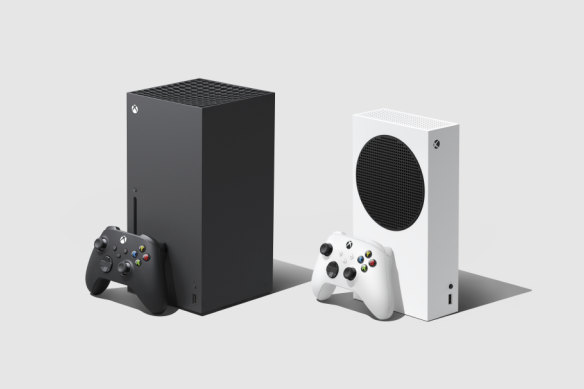
The Xbox Series X, left, and Xbox Series S are launching on Tuesday, November 10.
The lack of any brand new blockbuster games on day one is a shame, but that's countered somewhat by the excellent Game Pass subscription service that gets you an instant library of games to play for a monthly fee, and will include every one of Microsoft's own titles on the days they launch.
The console pair play the same games at two different levels of performance, which we'll get to further down, but they're also distinct physically.
The Series X is shaped like no other console (unless you count a stack of two Nintendo Gamecubes), with its 15x15x30cm black frame giving off industrial vibes. While it practically demands to be stood vertically out in the open where its massive exhaust fan can blast warm air upward, it works just as well (but looks slightly goofier) laid on its side.
Meanwhile the white Series S is just as deep and a little bit shorter than the Series X, but only 6cm wide. This makes it more of a traditional console shape but shockingly small compared to all previous Xbox systems.
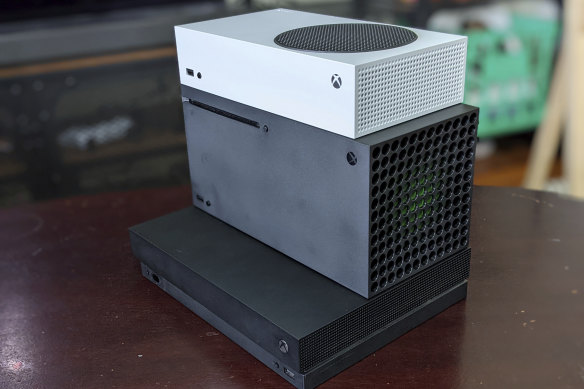
In addition to being smaller, the white Xbox Series S is also less fingerprint hungry than the Series X (middle) or the last generation One X.Credit: Tim Biggs
The bundled controller, in black or white, is ergonomically different from older Xbox pads; slightly smaller and weighted towards the back with much improved grips and directional pad, and a new share button for easier capture of clips and screenshots.
The systems also work with any older Xbox One controllers, headsets or other accessories you happen to have already, with the notable exception of the Kinect sensor which has been all but scrubbed from Microsoft history.
Outside of games the systems have ditched the HDMI input of the Xbox One, so you can't plug your set-top box into them, but they're still capable home theatre machines with support for Dolby Atmos sound and Dolby Vision HDR. They support the latest apps including Disney+ and Apple TV, and Series X can play video from 4K UHD Blu-rays.
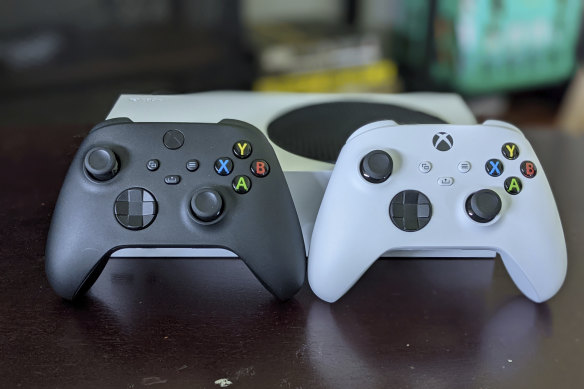
The new controllers look familiar at first glance, but offer an upgrade over Xbox One's standard pads.Credit: Tim Biggs
The first thing you'll notice when firing either console up is a big reduction in loading across the board, thanks to a cutting edge NVME solid state drive. The systems boot fast and, if you've ignored the power-saving settings, are essentially always ready to go at the press of a button. I found existing games that were designed for previous generation launched much quicker, with loading times mid-game also cut in half in many instances.
Every game that works on Xbox One works on Series X/S (minus the handful that require a Kinect), meaning more than 3000 games across Xbox One, Xbox 360 and original Xbox. In addition to faster loading, games that once struggled to hit their original framerate targets now do thanks to the massive increase in processing power, which can be transformative for some games and makes going back to older hardware feel like wading through molasses.
The greatest benefit of the SSD is a new feature called Quick Resume, which takes a snapshot of your game as you stop playing and saves it to storage. This snapshot persists even if you play other games or unplug the console, so when you return you can get back to exactly where you were in seconds. One downside of the SSD is that games optimised for the new consoles can not run off an external USB drive; you're stuck with the 1TB of internal space, or you can drop $360 on an additional 1TB drive that slots in the back.
Another thing you'll notice right away, if you had an Xbox One, is that when you sign in all the games you own digitally just show up, and your save data is synced in the cloud so you can just start playing. Most impressive are games supporting what Microsoft calls "Smart Delivery", which means if you own them on Xbox One they'll automatically upgrade to new, fully optimised next-gen versions on your new system for free, but your saves will be intact. If you didn't own an Xbox One and don't have games, Game Pass is $1 for the first month (then $11 per month), which is a great way to try some.
On paper the Series X is the most powerful games console around, and in practice it offers a noticeable upgrade over 2017's Xbox One X and a huge leap over anything older. With no truly new games available at launch I don't think we've come close to seeing the extent of its capabilities yet, but older unoptimised games play better than ever while the 30 or so "Series X/S optimised" games (including 23 upgraded from Xbox One via Smart Delivery) are a great introduction to next-gen.
2018's Forza Horizon 4 now runs at 4K and 60 frames per second and feels absolutely incredible, while Gears 5 has had its lighting and textures updated in line with the PC version's "Ultra" settings, and the multiplayer stepped up to a full 120 frames per second.
Framerates above 60 are brand new for console games, but you'll need a new TV as they require a display with HDMI 2.1. It looks buttery and feels more immediate on my LG CX OLED, and will likely become the standard for twitchy multiplayer shooters, but I'm also keen to play Ori and the Will of the Wisps when it's updated to 120 on launch day.
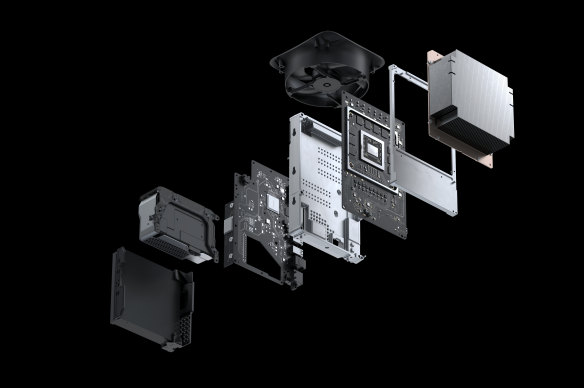
Inside the Series X's motherboard is split into two pieces, making for more efficient cooling and giving it its unconventional shape.
Overall 4K 60fps seems to be a standard this system can hit in its stride, with essentially every new game from Gears Tactics to Assassin's Creed Valhalla supporting it, which is a great step up from last generation with typically made you choose between the fidelity of higher resolution or the smoothness of higher framerate.
Unfortunately it's hard to talk to the quality of brand new games designed with the Series X hardware in mind, because to this point there really aren't any. It's possible once those games start rolling in we'll see some opt for lower resolution and 120fps, or intense raytracing and other graphical effects at lower framerates.
As for the smaller sibling, Microsoft's pitch for the disc-free Series S is that it plays all the same games as the bigger console at the same framerates, just at lower resolutions, and my initial testing seems to bear that out.
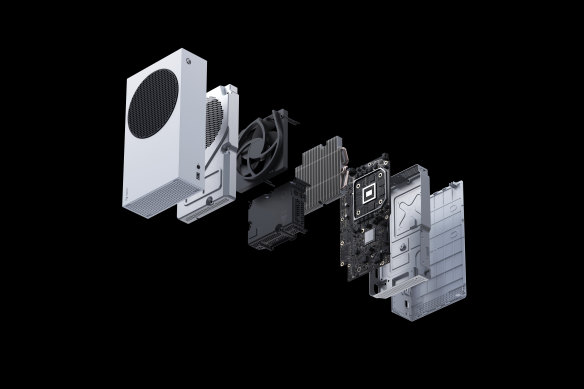
The Series S has a lower clocked processor and less RAM than the Series X, meaning games run at lower resolutions.
On Series S I saw all the same framerates for optimised games that I saw on Series X, including 120fps for Gears 5 multiplayer, which is stunningly impressive on a machine this small and inexpensive. SSD performance is the same, and games look great on a 4K TV even though in a side by side comparison you can tell they're running at 1080p or 1440p. On a Full HD TV there was little noticeable difference.
Past games still run better thanks to the SSD and CPU, but while Series X has access to game enhancements created for the Xbox One X, Series S does not. This is a shame because it means in some cases unoptimised games will run at 30fps on Series S and 60fps on Series X, even though they could both easily hit the higher spec. Hopefully this can be addressed in a future update.
Less fixable is the small 512GB hard drive; most people will get fewer than 10 games on there before they need to archive some to fit more. I'm also concerned about how Series S will hold up in the future. Microsoft's calculations say that if Series X can do it in 4K, then Series S can do it in 1440p, but that could be put to a harsh test in a few years when games are really pushing the Series X hardware.
On first impression these new consoles are a far cry from the lag and confusion of the Xbox One when it launched in 2013. They offer clear value regardless of whether you want the most performant console on the market or the least expensive way to get at next-gen games, and Microsoft continues to excel with software and services from Game Pass or Smart Delivery to the new Xbox app that helps you set up your console or notifies you about screenshots you took so you can share them on Twitter. Not to mention behind-the-scenes stuff you'll never notice like the AI-powered HDR system that makes games from as far back as 2001 look vibrant and colourful on modern TVs.
But there are also few reasons to upgrade from older consoles right at launch. With stunning updates to older games the main selling point here right now, most features available on (or coming to) older systems and only speculation around how much better a game like Cyberpunk 2077 or Halo Infinite will be on these consoles versus the One X, it could be a while before either new system is considered a must-have.